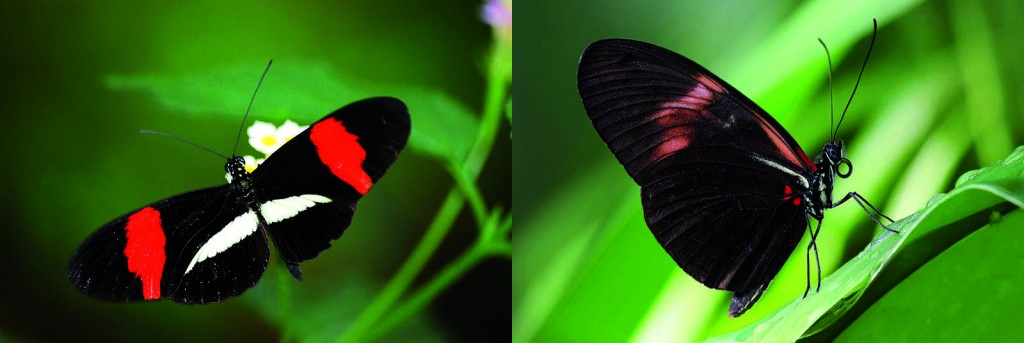MONDAY, 3 MAY 2010
A team of scientists led by researchers in the Department of Zoology have found two genome ‘hotspots’ responsible for the similarities between two distantly related species of butterfly.Heliconius erato and Heliconius melpomene are species found in Central and South America. Despite their distant relationship, both have evolved the same splashes of red and yellow on their black wings, signalling to predators that they are extremely unpalatable.
Surprisingly, despite butterflies having thousands of genes, the same narrow ‘hotspots’ (areas of frequent change) in the genome are altered in both species to produce the same visual patterns on their wings.
This finding is unexpected for two reasons. Firstly, the fact that identical genes have changed in both species points towards tighter constraints on possible mutations than expected. Secondly, the genes involved are not the expected candidates responsible for generating individual colours or for controlling their location on the wing. Instead, the genes in question are involved in general signalling pathways with other known functions and are not known to regulate wing patterning. This means that a tightly controlled and complex chain of molecular signals exist to result in a particular wing pattern.
Dr Chris Jiggins from the team said: “We think it’s more likely to be some novel method of cellular signalling, which could be important in many other insect species.” Jelena Aleksic
AID-ing the reversal of cell differentiation
Research at the Babraham Institute has revealed new insights into the process by which cells develop specific character and type through chemical transformations.
Cell fate is determined by both the actual genetic code of the cell and external factors such as chemical changes to the DNA (epigenetic marking) and associated proteins. One type of epigenetic marking is the addition (methylation) or removal (demethylation) of methyl groups from bases, which results in changes to the level of expression of that gene. It is now evident that one particular protein, AID, is crucial for complete cellular reprogramming and, through demeythlation, is able to completely remove the ‘identity tags’ of a specific cell.
It was already known that the embryo removed inherited methylation patterns early in development before forming new patterns of its own, but how and to what extent was a mystery. In collaboration with UCLA, Cambridge researchers have used next-generation sequencing technology to pinpoint exactly how this process works. They recorded huge drops in methylation levels, from 80 per cent to 7 per cent, when the cell reset took place, and showed that AID seems to be required for the resetting process to occur so thoroughly.
Problems in the regulation of this cell flexibility may be involved in diseases such as cancer. The discovery of how this protein regulates demethylation could have implications for regenerative medicine and stem cell research. Nicholas Gibbons
Currents of climate change
Researchers from the Department of Earth Sciences have found that millennial-scale and glacial-interglacial timescale changes in ocean circulation have different dynamics. Understanding the dynamics of oceanic currents is crucial for interpreting changes in the climate and may have implications for future climate predictions.
The team investigated changes in the isotope ratio of neodymium (Nd) in coatings precipitated on fish teeth and on a planktonic animal called foraminifera, allowing them to reconstruct past changes in water mass source and structure. Other isotope data using protactinium-231 (Pa) and thorium-230 (Th), highlighted changes in the circulation strength of the oceans. Using these data, both taken from the Bermuda Rise in the western North Atlantic, the scientists discovered different dynamics of ocean circulation. This is the first time such a comparison has been made.
During oceanic overturning, surface water is sent downwards, bringing up anoxic deep water, and killing many oxygen-breathing organisms. This process is associated with millennial-scale events and affects the upper ocean, unlike those associated with deglacial climate events, which affect the whole ocean.
The shifting of oceanic currents is inexorably linked to climatic changes, dynamics that must be better understood if we are to make accurate predictions of future change. Imogen Ogilvie


